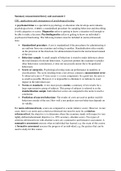Summary
Samenvatting Meten en Diagnostiek 1 Jaar 1.4 Psychologie
- Course
- Institution
- Book
Dit is een erg complete samenvatting voor het vak Meten en Diagnostiek van het eerste jaar psychologie. De samenvatting is geschreven aan de hand van het boek Psychological Testing van Robert Gregory, informatie uit de hoorcolleges en de artikelen op Canvas.
[Show more]




